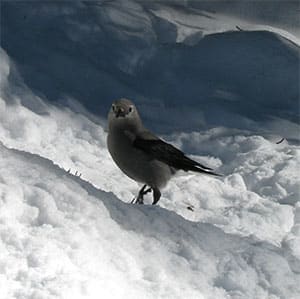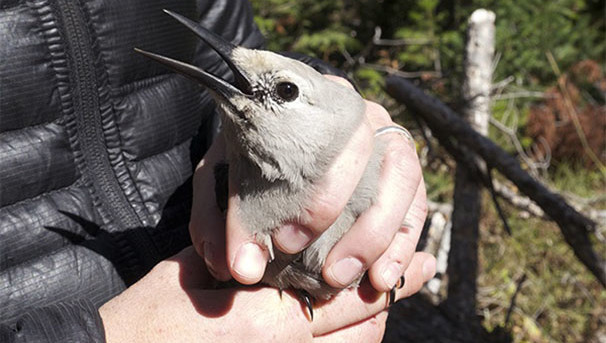This project is now in update mode. Check back regularly to see how things are progressing.
Destination Utah!
Utah is the trending hot spot for the satellite-tagged nutcrackers this winter. It turns out that some nutcrackers do head south: now four of our tagged nutcracker are in Utah.

A new documentary includes a piece on my nutcracker research
This week, on November 5th, Far Afield, A Conservation Love Story will premiere at the Center for the Arts, in Jackson, WY. I am thrilled to have been able to help in the making of this documentary about Bert Raynes, my friend and mentor. Ninety-one years old, Bert is a naturalist, author, and conservation icon in Jackson. Perhaps Todd Wilkinson put it best when he said "[Bert] is Jackson Hole's own version of The Lorax.” Bert has supported my research in so many ways, and grant funding from the Meg and Bert Raynes Fund has been crucial to the success of my research.
Jen and Ella (JenTen Productions) joined me in the field last fall to shoot footage for use in the documentary. I was happy that Jen also made the short video below, to show at a Jackson Hole Bird Club meeting.
Great news! Thanks to your help, we have reached 100% of our crowdfunding goal!
Great news! I'm thrilled to have reached 100% of our crowdfunding goal! Thank you so much for your support.
There are still nine days left, so any additional donations will help pay for more satellite transmitters.
This summer, I'm excited to head back to the field in Wyoming to both trap more nutcrackers to fit transmitters, and to ground-truth the habitat at all the satellite locations. In the meantime, it is exciting to watch where the tagged nutcrackers are moving - I am amazed at how much data I am collecting every day while behind the computer. I'm also working hard to publish the results from my occupancy surveys and radio-tracking.
How can nutcrackers possibly retrieve seeds from under the snow?
Several people have emailed to ask how it is possible for nutcrackers to access their seed stores during the winter's deep snowpack.
In fact, they use a variety of strategies. Clark’s nutcrackers regularly cache in exposed areas, such as steep cliffs and south facing slopes, where wind and sun prevent heavy snow accumulation. In one population in the Cascades, Teresa Lorenz found that the birds she studied cached up to 59% of seeds above ground. (The above ground caches were typically in needle clumps, in lichen or behind bark.) I didn't see nearly as much above ground caching, but I did see some. The birds tended to follow the snowline in the spring - I've watched them retrieving caches in recently melted open areas around the bases of trees, and right at the edge of melting snowpack, as the snowline recedes up a mountain. The birds also did retrieve caches from under the snow and ice. I have seen a Clark’s nutcracker dig diagonally down through about two feet of snow - its body was completely buried - then return to the surface with whitebark pine seeds (easily recognizable by the size). Harry Hutchins saw an individual peck through eight inches of ice to pull out seeds. Also, the birds are corvids, and like all corvids they are super opportunistic, and will eat other foods besides seeds when available. In the winter, this includes dead animals (such as roadkill or wolf kill), rodents, and insects hidden under tree bark. They especially love the suet I hang up to bait my traps.

Where are the Clark's nutcrackers now?
I attached satellite transmitters to the seven Clark's nutcrackers outside of Jackson, WY in fall 2014, so I have been following them for about a year now. During every season, the birds have regularly moved much further than we had expected.
The recent long-distance movements are exciting. One nutcracker flew about 220 miles north, halfway across Montana, then began moving slowly back toward Wyoming. A second is now in the Uinta Mountains on the Utah-Wyoming border. Another flew to pinyon-juniper woodland in southern Utah, near Escalante National Monument, over 400 miles away.
See the map for the location of where I trapped the nutcrackers (the black star), and the current locations of the three birds that moved out of the southern Greater Yellowstone Ecosystem. The red squares show all three birds' high accuracy locations from the last 20 days.

Off To a Great Start
Five days into the campaign, and we have already raised 25% of the $6,000 goal!
I am incredibly thankful for everyone who has given to the project so far.
If you want to hear more about the Clark's nutcracker research, watch the presentation I gave last fall at the 12th Biennial Scientific Conference on the Greater Yellowstone Ecosystem.
Population-wide failure to breed
In the initial stages of my research, I discovered that in two of the five years, none of the Clark’s nutcrackers at my study site were breeding. I didn’t catch any birds with brood patches, didn’t observe any radio-tagged nutcrackers building or sitting on nests, and didn’t see any juveniles in the entire ecosystem. Every other year, there was lots of breeding activity, and I saw lots of juveniles.
The two nonbreeding years, 2009 and 2011, followed low whitebark pine cone crops the previous autumn.
Declining whitebark pines could lead to an increase in nonbreeding years, which could have serious consequences for Clark’s nutcracker populations and the whitebark pine-Clark’s nutcracker mutualism.

Soul Mates: Nutcrackers, Whitebark Pine, and a Bond That Holds an Ecosystem Together
The Cornell Lab of Ornithology's quarterly magazine, Living Bird, which has 50,000+ print subscribers, is featuring my research and the Clark's nutcracker-whitebark pine story! Read the article (and check out the video clips) at http://www.allaboutbirds.org/soul-mates-nutcrackers-whitebark-pine-and-a-bond-that-holds-an-ecosystem-together/.

$20
Just over a week!
Just over a week of satellite tracking one Clark’s nutcracker. (I can collect fascinating data in this short amount of time. I’ve had a bird move ~220 mi north in under a week!)
$50
Three weeks!
Three weeks of tracking one Clark’s nutcracker. (Amazing how many times a bird could crisscross the Tetons in this time.)
$100
Six weeks!
Six weeks of tracking one Clark’s nutcracker. (In six weeks, a bird could finish the bulk of its autumn seed harvest.)
$200
Three months!
Three months of tracking one Clark’s nutcracker. (In three months during the spring, a bird could build a nest, raise young, and feed fledglings for their first few weeks out of the nest.)
$500
Seven months!
Seven months of tracking one Clark’s nutcracker. (That's the breeding season, summer, and the autumn harvest.) Or, thinking about this another way: this would also fund one month tracking all seven nutcrackers!
$1,700
Two birds
Fund two birds with one gift. A gift at this level allows me to track two birds for a full year.



